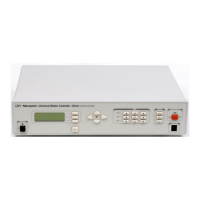The output has two signals, commonly known as channel A and
channel B. Some encoders have analog outputs (sine – cosine signals)
but the digital type are more widely used. Both channels have a 50%
duty cycle and are out of phase by 90°. Using both phases and an
appropriate decoder, a motion controller can identify four different
areas within one encoder cycle. This type of decoding is called X4 (or
quadrature decoding), meaning that the encoder resolution is
multiplied by 4. For example, and encoder with 10 µm phase period
can offer a 2.5 µm resolution when used with a X4 type decoder.
A
B
1234
Figure 5.26: Encoder Quadrature Output
Physically, an encoder has two parts: a scale and a read head. The
scale is an array of precision placed marks that are read by the head.
The most commonly used encoders, optical encoders, have a scale
made out of a series of transparent and opaque lines placed on a glass
substrate or etched in a thin metal sheet (
Figure 5.27).
Figure 5.27: Optical Encoder Scale
Section 5 – Motion Control Tutorial 5-23

